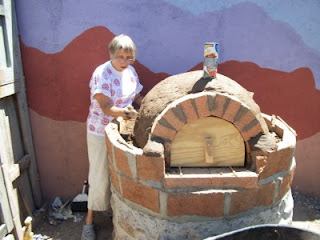The adobe came from collapsing walls and buildings on our friend Tom's property. It's sort of like "ashes to ashes, dust to dust" except here it is "adobe to adobe." It turns out that the crumbling stuff is an ideal mix of clay and sand to re-hydrate, turn back into mud, and use to build an adobe oven.
 |
| Preparing the oven site - Fall 2010 |
 |
| Bread baking in a Moroccan nomad oven |
Also, since I was a child, I have been attracted to off the grid independence. I used to fantasize about living far from civilization and needing no one. Yeah - I know - after years of therapy I can analyze the heck out of that, but in the end, there you have it...the idea still holds an attraction even now. I figured I'd better build that oven while I have the energy and cleanse that desire from my karma! Besides, a challenge is always good for the soul.
So off we went to Tom's vacant lot. Dan is still nursing a broken clavicle from the accident and was grumbling all the way. But I have to give him credit - he did it. Together we shoveled up and screened 10 buckets of dirt from amidst the rocks, squashed beer cans,cement chunks and broken tree trunks. Even at 10 AM the sun was high and the air was hot. Sweat poured from every inch of me, but it felt so good to see those buckets fill with fine adobe dust. It took less than an hour.
 |
| Oven base built by Ramón and Fito |
In the process of designing the oven, I happened upon a wonderful book: Build Your Own Earth Oven by Kiko Denzer and Hanna Field. This book became my adobe bible and as I have followed its directions the process has turned into an ongoing adventure.
Step one was to insulate the floor. According to the book, we needed sawdust. Dan and I went down the road to Aconchi to the carpenter's shop and asked for some. The workmen pointed us to a waist high pile of the stuff, but stared at us with disbelief when I tried to explain to them what it was for. we shoveled it into buckets and headed out before anyone could change their mind about giving it to us.
The next step was to find a whole bunch of old beer bottles to lay on their sides to cover the bottom. The bottles hold air and provide additional insulation for the base. That brought about a trip to the Banámichi dump where we scrounged among the smoldering fires and piles of branches, broken piñatas, household trash and shocking amounts of non-bio-degradable plastics. I finally found enough beer bottles, and returned home with the funky smell of burning garbage in my nostrils and on my clothes.
It is an interesting cultural experience to compare the Banámichi dump with the one in Tucson. Americans throw out amazing amounts of eminently useable items. Whenever I go to the Tucson dump, I see things I want to bring home and use, but that is not allowed. Once I saw a man hurling perfect 6 foot long pine boards on the heap. Here in Mexico, when something goes to the dump, it is well and truly used up - clothing that has become rags, furniture broken beyond recognition, shattered toys. In Mexico, even old glass jars and bottles are re-used for honey and salsa.
 |
| Base with bottles imbedded in adobe-sawdust mix |
The fire brick floor went down easily enough, but the arch was a struggle. Cutting the tough firebricks on the tile saw was a bit of a challenge. The saw jammed and then threw one of the bricks clear across the patio. I'm glad I was not in the way of that brick. The darned things have been trying to kill me! But they were finally tamed when my first-ever arch brick stood by itself!
 |
| Newspaper covered sand form. Check out the cool arch! |
 |
| Finishing the thermal mud layer |
to grab a loose handful of wet mud and pat and prod it into place so it became part of the whole. The beautiful dome gradually emerged. After the mud was in place for awhile, the water in it began to evaporate, and the texture was cool and sensual. It was good to feel the earth on my hands, the mud squishing between my fingers.The day was hot and sunny, and I would have loved to immerse myself in the stuff.
It seems somehow significant that I did most of the mud work on my 68th birthday and that I did most of it by myself. I am pleased with the result and it feels like there has been a completion in my soul. Whatever need that was driving me has been fulfilled...but I am still excited about baking bread and pizza!
Also, I am tired. My body aches, and the muscles are screaming "Enough Already!" I have come to the realization that I don't have many more of these big do-it-yourself projects left in me, and that is OK now.
To be continued....

I love it! The pictures, the work, the design, the drive to do it, the results, Wonderful! Just love it. Good for you June for following through and for letting yourself have this wonderful pleasure. Can't wait for the more to come...
ReplyDeleteHey June, Just thinking about you and wondering how it's going. Waiting patiently for the next blog post!
ReplyDeleteHey June,
ReplyDeleteNudge nudge. Time for a new post... Hey friend. I miss you. Thanks for keeping in touch though. levonnegaddy@hotmail.com